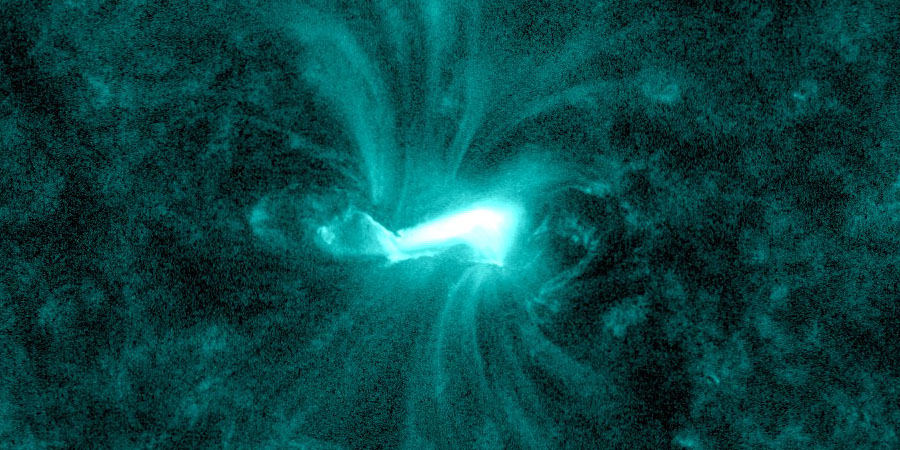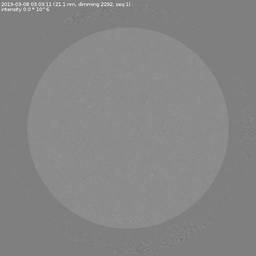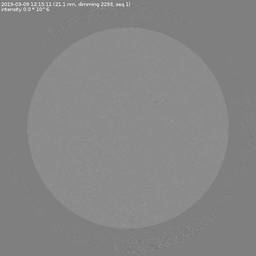Eruptive flares, NOAA G1 watch
Sunday, 10 March 2019 19:45 UTC

The past few days, sunspot region 2734 faced Earth. While the sunspot region wasn't very complex it was the first proper sunspot region in quite some time and produced a couple of small solar flares. The two most noteworthy events were a C1.3 solar flare on 8 March and a B6.5 solar flare on 9 March. While B and C class solar flares aren't very interesting normally, these two events showed signs that they might have ejected some solar plasma into space. Keep on reading to find out more...
C1.3 solar flare

We start of the C1.3 solar flare that peaked at 03:18 UTC on 8 March. This solar flare was a fairly long duration event and peaked twice. Once at C1.3 and a little later at C1.2. This event was associated with a Type II radio sweep.
Looking at the coronagraph imagery from SOHO, we do see some faint ejecta leaving the Sun, both towards the left and right of SOHO's field of view. We suspect these are two separate coronal mass ejections based on how the eruption evolved. If you look closely at the animation above you first see an eruption from the region's leading portion followed by a secondary eruption from the region's trailing portion which makes us think there were two coronal mass ejections launched by this event but neither of them really aimed heads on towards our planet but its still likely we will at least experience some effects from this event here on Earth.
The NOAA SWPC has issued a minor G1 geomagnetic storm watch for tomorrow (Monday 11 March) as a result of this event but we come to a different conclusion. We expect the coronal mass ejection(s?) to take a little more time than just three days as this plasma cloud wasn't fast at all at a reported speed of only 440 km/s which is slightly faster than the ambient solar wind. A transit time of about 4 days seems much more reasonable which means an enhancement on March 12 (Tuesday) seems much more likely. This puts our prediction much more in line with the prediction done by the European SIDC.
Minor G1 geomagnetic storm conditions also seem a bit of a stretch as this is only a minor event. Only if we are in luck and the plasma cloud carries with it a sustained southward pointing magnetic field (Bz) we would have a chance of minor G1 geomagnetic storm conditions. Due to the slow nature of this plasma cloud we do not expect to see much of a shock in the solar wind upon arrival but an enhanced interplanetary magnetic field strength should reveal the passage of the magnetic cloud as it arrives at our planet.
B6.5 solar flare

...and the other event? What did the B6.5 solar flare produce you ask? While the event was associated with a coronal wave and coronal dimming, there was very little ejecta to be seen on the SOHO and STEREO Behind coronagraph imagery. A very faint plasma cloud was ejected but its speed is slow and does not exceed 200 km/s which is much slower than the ambient solar wind. This coronal mass ejection could easily take 5 days to bridge the Sun-Earth distance but we do not expect its impact to be visible due to the fact that this coronal mass ejection is very faint and slow. We'd expect it to blend in in the ambient solar wind. A slight increase in the strength of the interplanetary magnetic field might be possible but we should not expect any major effects from this plasma cloud here at Earth.
Long story short, we had two minor solar flares that ejected two (or three) faint coronal mass ejections in the general direction of Earth. However, due to the faint and slow nature of these coronal mass ejections their impact at Earth will likely be limited and minor G1 geomagnetic storm conditions seem unlikely.
Thank you for reading this article! Did you have any trouble with the technical terms used in this article? Our help section is the place to be where you can find in-depth articles, a FAQ and a list with common abbreviations. Still puzzled? Just post on our forum where we will help you the best we can!
Latest news
Latest forum messages
More topicsSupport SpaceWeatherLive.com!
A lot of people come to SpaceWeatherLive to follow the Sun's activity or if there is aurora to be seen, but with more traffic comes higher server costs. Consider a donation if you enjoy SpaceWeatherLive so we can keep the website online!

Space weather facts
| Last X-flare | 2025/03/28 | X1.1 |
| Last M-flare | 2025/04/01 | M2.4 |
| Last geomagnetic storm | 2025/03/27 | Kp5 (G1) |
| Spotless days | |
|---|---|
| Last spotless day | 2022/06/08 |
| Monthly mean Sunspot Number | |
|---|---|
| February 2025 | 154.6 +17.6 |
| April 2025 | 147 -7.6 |
| Last 30 days | 128.8 -21.8 |


